The GeForce GTX 660 Ti Review, Feat. EVGA, Zotac, and Gigabyte
by Ryan Smith on August 16, 2012 9:00 AM ESTPower, Temperature, & Noise
As always, we’re wrapping up our look at a video card’s stock performance with a look at power, temperature, and noise. Like we discussed in the introduction, while the official TDP of the GTX 660 Ti is 150W – 20W lower than the GTX 670 – the power target difference is only 7W. So let’s see which is more accurate, and how that compares to AMD’s cards.
| GeForce GTX 660 Ti Voltages | ||||
| Zotac GTX 660 Ti Boost Load | EVGA GTX 660 Ti Boost Load | Gigabyte GTX 660 Ti Boost Load | ||
| 1.175v | 1.162v | 1.175v | ||
Stopping to take a quick look at voltages, there aren’t any big surprises here. NVIDIA would need to maintain the same voltages as the GTX 670 because of the identical clocks and SMX count, and that’s exactly what has happened. In fact all single-GPU GK104 cards are topping out at 1.175v, NVIDIA’s defined limit for these cards. Even custom cards like the Gigabyte still only get to push 1.175v.
Up next, before we jump into our graphs let’s take a look at the average core clockspeed during our benchmarks. Because of GPU boost the boost clock alone doesn’t give us the whole picture – particularly when also taking a look at factory overclocked cards – we’ve recorded the clockspeed of our video cards during each of our benchmarks when running them at 2560x1600 and computed the average clockspeed over the duration of the benchmark. Unfortunately we then deleted the results for the factory overclocked cards, so we only have the “reference” card. Sorry about that guys.
| GeForce GTX 600 Series Average Clockspeeds | |||||||
| GTX 670 | GTX 660 Ti | Zotac GTX 660 Ti | EVGA GTX 660 Ti | Gigabyte GTX 660 Ti | |||
| Max Boost Clock | 1084MHz | 1058MHz | 1175MHz | 1150MHz | 1228MHz | ||
| Crysis | 1057MHz | 1058MHz | N/A | ||||
| Metro | 1042MHz | 1048MHz | |||||
| DiRT 3 | 1037MHz | 1058MHz | |||||
| Shogun 2 | 1064MHz | 1035MHz | |||||
| Batman | 1042MHz | 1051MHz | |||||
| Portal 2 | 988MHz | 1041MHz | |||||
| Battlefield 3 | 1055MHz | 1054MHz | |||||
| Skyrim | 1084MHz | 1045MHz | |||||
| Civilization V | 1038MHz | 1045MHz | |||||
The average clockspeeds on our “reference” GTX 660 Ti don’t end up fluctuating all that much. With a max boost of 1058 the card actually gets to run at its top bin in a few of our tests, and it isn’t too far off in the rest. The lowest is 1035 for Shogun 2, and that’s only an average difference of 22MHz. The GTX 670 on the other hand had a wider range; a boon in some games and a bane in others. If nothing else, it means that despite the identical base and boost clocks, our cards aren’t purely identical at all times thanks to the impact of GPU boost pulling back whenever we reach our power target.
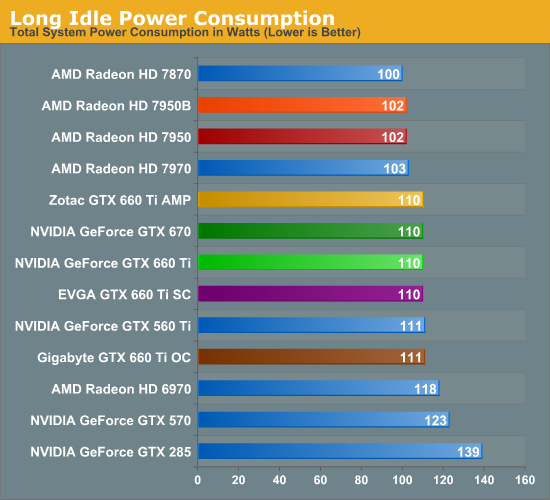
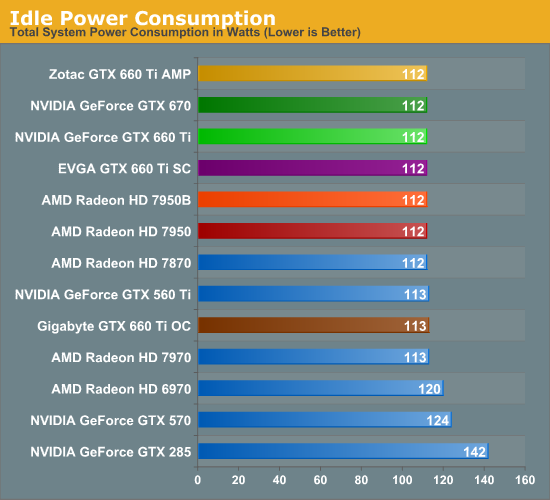
There are no great surprises with idle power consumption. Given the immense similarity between the GTX 670 and GTX 660 Ti, they end up drawing the same amount of power both during idle and long idle. This does leave AMD with an 8W-10W lead at the wall in this test though.
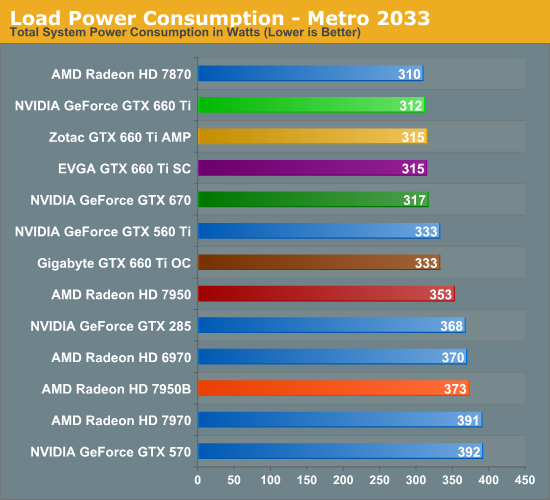
Moving on to our load power tests we start with Metro: 2033. As we mentioned previously the GTX 660 Ti and GTX 670 have very similar power targets, and this benchmark confirms that. Power consumption for the GTX 660 Ti is virtually identical to the Radeon HD 7870, an interesting matchup given the fact that this is the first time NVIDIA has had to compete with Pitcairn. Pitcairn’s weaker compute performance means it starts off in a better position, but it looks like even with a salvaged GK104 NVIDIA can still compete with it. NVIDIA drove efficiency hard this generation; to compete with a smaller chip like that is certainly a testament to that efficiency.
As for the inevitable 7950 comparison, it’s no contest. The GTX 670 was already doing well here and the GTX 660 Ti doesn’t change that. Tahiti just can’t match GK104’s gaming efficiency, which is why AMD has had to push performance over power with the new 7950B.
Meanwhile it’s fascinating to see that the GTX 660 Ti has lower power consumption than the GTX 560 Ti, even though the latter has the advantage of lower CPU power consumption due to its much lower performance in Metro. Or better yet, just compare the GTX 660 Ti to the outgoing GTX 570.
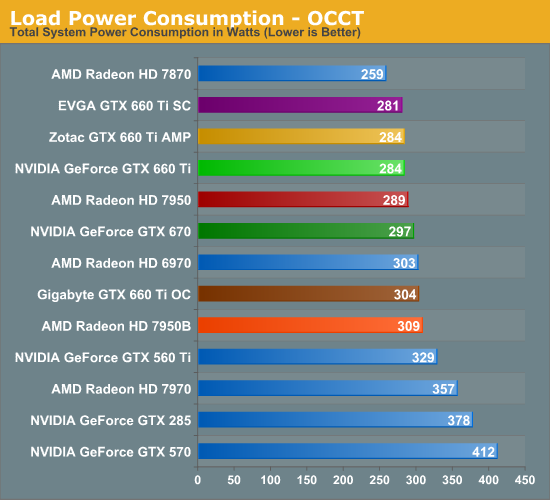
For AMD/NVIDIA comparisons we have a bit less faith in our OCCT results than we do our Metro results right now, as NVIDIA and AMD seem to clamp their power consumption differently. NVIDIA’s power consumption clamp through GPU Boost is far softer than AMD’s PowerTune. As a result the 7870 consumes 25W less than the GTX 660 Ti here, which even with AMD’s very conservative PowerTune rating seems like quite the gap. Metro seems to be much more applicable here, at least when you’re dealing with cards that have similar framerates.
In any case, compared to NVIDIA’s lineup this is another good showing for the GTX 660 Ti. Power consumption at the wall is 45W below the GTX 560 Ti, a large difference thanks to the latter’s lack of power throttling technology.
As for our factory overclocked cards, these results are consistent with our expectations. Among the Zotac and EVGA cards there’s a few watts of flutter at best, seeing as how they have the same power target of 134W. Meanwhile the Sapphire card with its higher power target is 20W greater at the wall, which indicates that our estimated power target of 141W for that card is a bit too low. However this also means that those times where the Gigabyte card was winning, it was also drawing around 20W more than its competition, which is a tradeoff in and of itself.
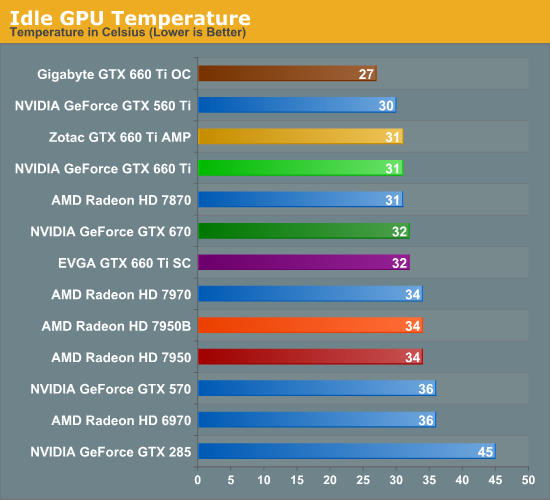
Moving on to temperatures, at 31C the GTX 660 Ti is once more where we’d expect it to be given the similarities to the GTX 670. Open air coolers tend to do a bit better here than blowers though, so the fact that it’s only 1C cooler than the blower-type GTX 670 is likely a reflection on Zotac’s cooler.
Speaking of factory overclocked video cards, one card stands out above the rest: the Gigabyte GTX 660 Ti. That oversized cooler does its job and does it well, keeping the GPU down to barely above room temperature.
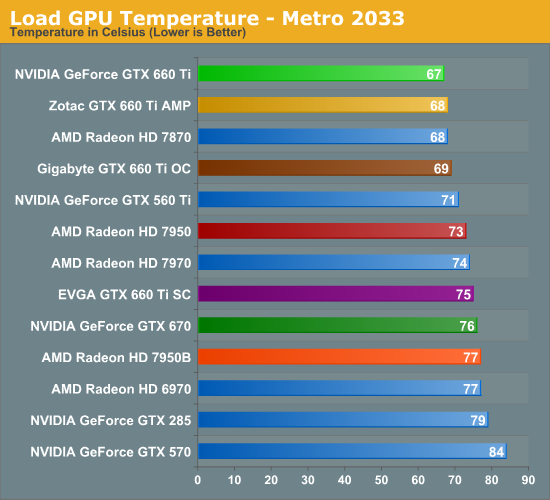
Considering that most of our high-end cards are blowers while our “reference” GTX 660 Ti is an open air cooler, temperature benchmarks are the GTX 660 Ti’s to win, and that’s precisely what’s going on. 67C is nice and cool too, which means that the open air coolers should fare well even in poorly ventilated cases.
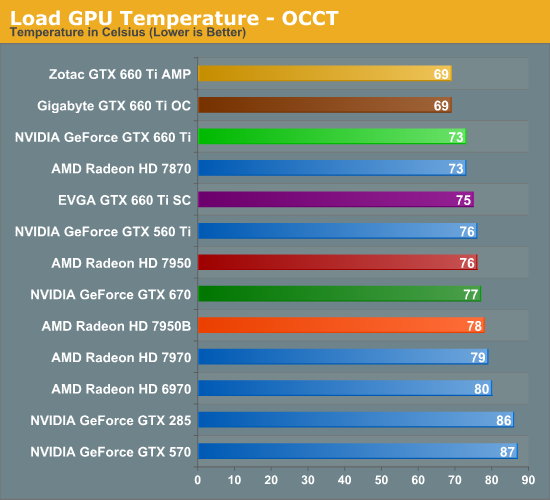
As usual we see a rise in temperatures when switching from Metro to OCCT, but at 73C the GTX 660 Ti is still the coolest reference (or semi-reference) card on the board. To be honest we had expected that it would beat the 7870, but as far as blowers go the 7870’s is quite good.
Moving on to our factory overclocked cards, we’re seeing the usual divisions between open air coolers and blowers. The blower-based EVGA card performs almost identically to the GTX 670, which makes sense given the similarities between the cards. Meanwhile the open air Zotac and Gigabyte cards are neck-and-neck here, indicating that both cards are shooting for roughly the same temperatures, keeping themselves below 70C. Though it’s somewhat weird to see the factory overclocked Zotac card end up being cooler than its reference-clocked self; this appears to be a product of where the fan curve is being hit.
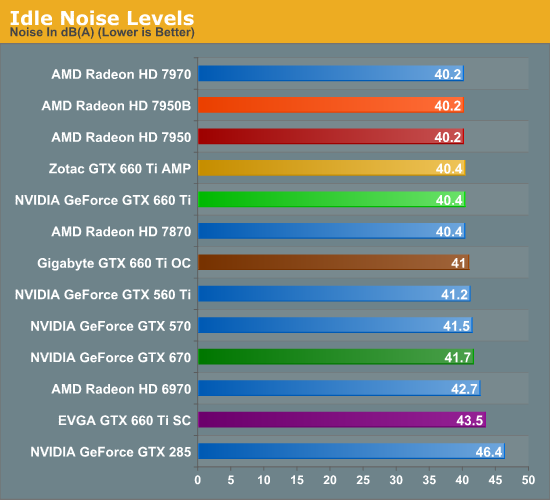
Last but not least we have our look at noise, where we’ll hopefully be able to fully shake out our factory overclocked cards.
Right off the bat we see the blower-based EVGA struggle, which was unexpected. It’s basically the same cooler as the GTX 670, so it should do better. Then again the EVGA GTX 670 SC had the same exact problem.
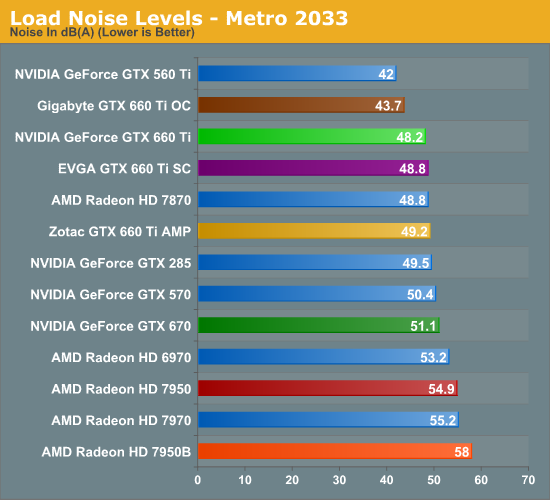
As for Metro, the GTX 660 Ti once again looks good. 48.2 isn’t the best for an open air cooler, but it’s a hair quieter than the 7870 and notably quieter than the GTX 670. The only unfortunate part about these results is that it just can’t beat the GTX 560 Ti; in fact nothing can. For its power consumption the GTX 560 Ti was an almost unreal card, but it’s still a shame the GTX 660 Ti can’t be equally unreal.
Moving on to our factory overclocked cards however, the Gigabyte GTX 660 Ti OC gets very close thanks to its very large cooler. 43.7dB technically isn’t silent, but it just as well should be. To offer the performance of a GTX 660 Ti (and then some) in such a package is quite the accomplishment.
As for Zotac and EVGA, there’s nothing bad about either of them but there’s also nothing great. EVGA’s card is about average for a blower, while Zotac’s card seems to be suffering from its size. It’s a relatively tiny card with a relatively tiny cooler, and this has it working harder to hit its temperature targets.
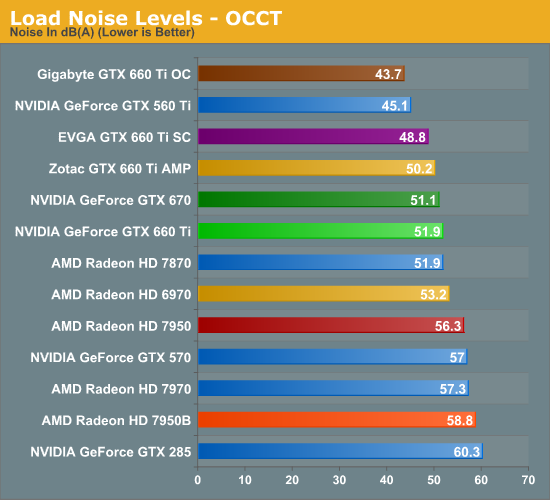
Finally we have noise testing with OCCT. Our “reference” GTX 660 Ti actually fares a bit worse than the GTX 670, which is unfortunate. So much of this test comes down to the cooler though that it’s almost impossible to predict how other cards will perform. At least it’s no worse than the 7870.
Meanwhile the Gigabyte GTX 660 Ti OC continues to impress. 43.7dB not only means that it didn’t get any louder switching from Metro to OCCT, but it has now bested the GTX 560 Ti thanks to the 560’s lack of power throttling technology. Make no mistake, 43.7dB for this kind of performance is very, very impressive.
As for EVGA and Zotac, it’s also a rehash of Metro. EVGA’s blower is actually over 1dB quieter than Zotac’s cooler, which is an unfortunate outcome for an open air cooler.
Wrapping things up, even without a true reference sample from NVIDIA it’s clear that the GTX 660 Ti has a lot of potential when it comes to power/temp/noise. Compared to other cards it’s roughly equivalent in power consumption and noise to the 7870, which for NVIDIA is an important distinction since it’s also notably faster than the 7870, so NVIDIA is on a better place on the power/performance curve. This goes for not only the 7870, but especially the 7950, where the GTX 660 Ti continues the tradition the GTX 670 already set, which will see the GTX 660 Ti being cooler, quieter, and less power hungry than AMD’s entry-level Tahiti part.
But it must be pointed out that the lack of a reference design for the GTX 660 Ti means buyers are also facing a lot of variability. Power consumption should be consistent between cards – which is to say a hair less than the GTX 670 – but temperature and especially noise will vary on a card by card basis. Potential buyers would best be served by checking out reviews ahead of time to separate the duds from the gems.










313 Comments
View All Comments
claysm - Friday, August 24, 2012 - link
I absolutely will ignore driver support for the 6 series cards. If you are using an AGP card, it's really REALLY time to upgrade.You are just as bad a fanboy for nVidia as any AMD guy here, moron. You are completely ignoring anything good about AMD just because it has AMD attached to it.
I'm completely confident that if AMD had introduced adaptive v-sync and PhysX, you would still say they suck, just because they came from AMD. If you read my post, it says that 660 Ti IS more powerful than the 7870. I was just pointing out that they are closer than they seem. I have no nVidia hatred, they have a lot of cool stuff.
And about the 660 Ti beating the 7950 at 5760x1080, look at the other three benchmarks, moron. The 7950 wins all of them, meaning BF3, Dirt 3, and Crysis 2. It only looses in Skyrim by and average of 2 FPS. Why didn't you include those games in your response.
And when I left the games out, I said that they merely blew the average out of proportion, but that you can't leave them out because you want to. You still have to calculate them in the total. Moron.
And for the record, I'm running a GTX 570, moron.
CeriseCogburn - Friday, August 24, 2012 - link
Look, the amd crew, you, talk your crap of lies, then I correct you.That's why.
Now, whatever you have that is "good by amd" go ahead and state it. Don't tell lies, don't spin, don't talk crap.
I'm waiting...
My guess is I'll have to correct your lies again, and your STUPID play dumb amnesia.
The reason one game was given with 660Ti in that highest resolution winning is very obvious, isn't it, the endless your bud giradou or geradil or geritol whatever his name is was claiming that's the game he was buying the 7950 for...
LOL
ROFL
MHO
Whatever - do your worst.
CeriseCogburn - Saturday, August 25, 2012 - link
" Fan noise of the card is very low in both idle and load, and temperatures are fine as well.Overall, MSI did an excellent job improving on the NVIDIA reference design, resulting in a significantly better card. The card's price of $330 is the same as all other GTX 660 Ti cards we reviewed today. At that price the card easily beats AMD's HD 7950 in all important criteria: performance, power, noise, heat, performance per Dollar, performance per Watt. "
LOL
power target 175W LOL
" It seems that MSI has added some secret sauce, no other board partner has, to their card's BIOS. One indicator of this is that they raised the card's default power limit from 130 W to 175 W, which will certainly help in many situations. During normal gaming, we see no increased power consumption due to this change. The card essentially uses the same power as other cards, but is faster - leading to improved performance per Watt.< br />Overclocking works great as well and reaches the highest real-life performance, despite not reaching the lowest GPU clock. This is certainly an interesting development. We will, hopefully, see more board partners pick up this change. "
Uh OH
bad news for you amd fanboys.....
HAHAHHAHAHAHAAAAAAAAAAAAAA
The MSI 660Ti is uncorked from the bios !
roflmao
Ambilogy - Friday, August 24, 2012 - link
"I don't have a problem with that. 660Ti is hitting 1300+ on core and 7000+ on memory, and so you have a problem with that.The general idea you state, though I'M ALL FOR IT MAN!
A FEW FPS SHOULD NOT BE THE THING YOU FOCUS ON, ESPECIALLY WHEN #1 ! ALL FOR IT ! 100% !"
So you have not a problem with performance? good, because actually that means its a competitive card, not a omfg card. And if you want to oc a 660 you would just oc a 7950 so I don't see the omfg nvidia is so much better.
"Thus we get down to the added features- whoops ! nVidia is about 10 ahead on that now. That settles it.
Hello ? Can YOU accept THAT ?"
So essentially when i ask how many people do actually 3D because you seem to think 2% is unimportant in resolution your answer is "well nvidia is 10 ahead because it has features ACCEPT BLINDLY". Not smart.
"Nope, it's already been proven it's a misnomer. Cores are gone , fps is too, before memory can be used. In the present, a bit faster now, cranked to the max, and FAILING on both sides with CURRENT GAMES - but some fantasy future is viable ? It's already been aborted.
You need to ACCEPT THAT FACT."
FPS are gone and future is fantasy? amd cards still perfom, they are very gpgpu focused and they do excellent for that, and still they don't have bad gaming performance while doing it because you just buy a pre OC version or something and you get still awesome performance (very similar to your 660ti god), say to me what is not enjoyable while playing with an AMD card mr fanboy.
And the future, well, future is gpgpu because allows big improvements to computing, yet is "fantasy". It's only non important because nvidia had good gpgpu in the past and not now?
"Okay, so whatever that means...all I see is insane amd fanboysim - that's the PR call of the loser - MARKETING to get their failure hyped.."
Yeah, calling fan-boy before actually noticing that nvidia told the reviewers how to review the card so it looked better, because get realist, if they include a horrible AA technique with no reason at all something is behind the table hiding you know. Haven't you noticed? theres a lot of discrepancy in 660ti's benchmarks around the web, from sites where the 660 loses to 870's radeons and where it wins to 970's, there is not a single liable review now, do you want to see the truth? buy a 660ti a 870 and a 950, and compare the 3, you will have the truth, thay they perform like they are priced and AMD cards are not shit.
CeriseCogburn - Saturday, August 25, 2012 - link
Hey, I answered the guys 3 questions. I made my points. I didn't say half of what you're talking about, but who cares.
The guy killed himself with point #1, so that's the end of it.
CeriseCogburn - Saturday, August 25, 2012 - link
Oh stop the crap. nVidia is 10 features ahead, I'm not the one who talked about resolution usage, so you've got the wrong fellow there.3D isn't the only feature... but then you know that, but will blabber like an idiot anyway.
Go away.
claysm - Saturday, August 25, 2012 - link
"I'm not the one who talked about resolution usage". You can't fault him for mixing up his trolls. Since almost everything you and TheJian have said is complete shit it's hard to keep track of who said what.And if you can objectively prove that I've lied about anything, I really would like to see it. And I mean objectively, not your usual response of entirely subjective 'AMD suckz lololol' presented in almost unreadably bad grammar.
I take that back, I won't read it anyways, since I know already know it'll be an nVidia love fest regardless of what the facts state. And I'll reiterate that I'm using an nVidia card. Moron.
CeriseCogburn - Saturday, August 25, 2012 - link
Oh it is not, he showed it all to be true and so does the review man.Get out of your freaking goggled amd fanboy gourd.
Look, I just realized another thing that doesn't bode well for you..
What nVidia did here was make a very good move, and the losses of amd on the Steam Hardware Survey at the top end are going to increase....
The amd fanboy is constantly crying about price - they're going to look at $299 with the excellent new game for free and PASS on the more expensive 7950 Russian is promoting EVEN MORE now.
Here let me get you the little info you're now curious about. ( I hope but maybe you're just a scowling amd fanboy liar still completely uninterested because you never got 1 fact according to you LOL sad what you are it's sad)
Aug 15th 2012 prdola0
" Looking at Steam Survey, it is clear why AMD is so desperate. GTX680 has 0.90% share, while even the 7850 lineup has less, just 0.62%. If you look at the GTX670, it has 0.99%. The HD7970 has only 0.54%, about half of what GTX680 has, which is funny considering that the GTX680 is selling only half the time compared to HD7970. It means that GTX680 is selling 4 times faster."
ROFL...
No one is listening to you fools, Russian included... now it's going to GET WORSE for amd....
CeriseCogburn - Saturday, August 25, 2012 - link
forgot link, sorry, page 2 commenthttp://www.anandtech.com/show/6152/amd-announces-n...
Okay, and that stupid 7950 boost REALLY IS CRAPPY CHIPS from the low end loser harvest they had to OVER VOLT to get to their boost...
LOL
LOL\
OLO
I mean there it is man - the same JUNK amd fanboys always use to attack nVida talking about rejected chips for lower clocked down the line variants has NOW COME TRUE IN FULL BLOWN REALITY FOR AMD....~!
HAHHAHAHAHAHAHAHHAHA
AHHAHAHAHAHAA
omg !
hahahahahahhahaha
ahhahaha
ahaha
Holy moly. hahahahahhahahha
CeriseCogburn - Thursday, August 23, 2012 - link
plus here the 660Ti wins in 5760x1080, beating the 7950 the 7950 boost, and the 7970...http://www.bit-tech.net/hardware/2012/08/16/nvidia...
Skyrim. So, throw that out too - add skyrim to your too short shortlist. Throw out your future mem whine. throw out your OC whine readied for 660Ti...
Yep. So the argument left is " I wuv amd ! " - or the more usual " I OWS nVidia ! " ( angry face )